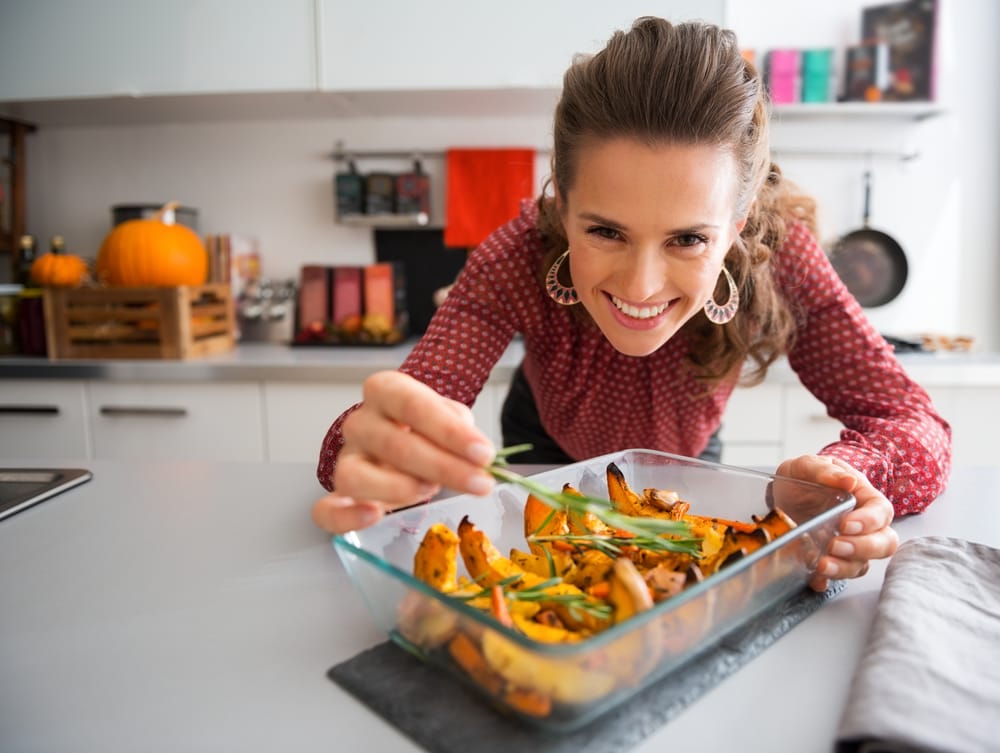Television ads don’t do the holidays justice when it comes to healthy eating at Thanksgiving – and Christmas and New Year’s. The image of a plump Thanksgiving turkey on a banquet table filled to overflowing may serve as a trigger to over-prepare high-fat, high-sugar foods and overeat at the table. While we can’t stop such advertising, we can turn off the TV or switch channels when it comes on. Still, the seeds may already have been planted, and coupon inserts in the newspaper with color photos of decadent, rich foods for family and other festivities will just add to the cravings. How can Americans combat the tendency to overeat? Here are some tips to help you hold off on that extra drumstick and eat mindfully this Thanksgiving. Make healthy food choices and be more active. For millions of Americans, there’s only an extra pound registered on the scale after the annual turkey day festivities. But according to a study by the National Institutes of Health, that pound may never come off, increasing the likelihood of becoming overweight or obese and risking the related health problems. An earlier study found weight gains of 5 to 15 pounds during the holiday season. The key to avoiding or minimizing such weight gain and risk is to make healthy and healthier food choices and to be more active with regular physical exercise during the holiday period, generally considered from Thanksgiving through New Year’s. Be aware of time commitments that disrupt schedules. Shopping for ingredients for the holiday meal, planning and decorating and running last-minute errands, coupled with social, business and/or family obligations can disrupt anyone’s schedule. This includes the structured meals that may be part of our sensible eating regimen. The temptation to snack on junk food, to toss out regular eating routines and just indulge in mindless eating can wreak havoc on our waistlines and our self-image. Factor in extra time to get chores and errands done, and never go out on an empty stomach. Eat light, nutritious meals or a snack before venturing out or tackling any holiday-related activity. Opt for different ways to socialize. With hours to while away before the sit-down dinner, there’s too much temptation to stuff yourself with hors d’oeuvres and salty, sugar or fat-rich or calorie-laden snacks. Break this snackfest by initiating a family game of flag football, encouraging everyone to go for a brisk walk, or engaging in some other form of vigorous physical exercise — both before and after dinner. While it’s usually the tryptophan in turkey that gets blamed for post-meal sleepiness, studies show the real culprits are overeating and increases in sugar levels. So, after the holiday meal, lead the way by having family members bundle up and go for a walk. That will help you avoid picking on leftovers and assist in burning off some of the calories you just consumed. This strategy is recommended for diabetics, people with eating disorders and most Americans in general. Eat healthful foods throughout the day. Nutrition experts recommend eating small, healthy snacks throughout the day rather than starving yourself waiting for the big family meal. Consider eating an apple with a spoonful of peanut butter, a hard-boiled egg or yogurt. That way, when family gathers around the table and the blessings are given, you won’t be diving into the platters like it’s your last meal. Swapping the usual culprits for healthier items during or just prior to the meal is another good strategy. Try a whole-wheat pita or bread instead of white, use brown or wild instead of white rice, maybe a sugar-free Jello or yogurt parfait instead of an extra piece of pie. Add more fruits and vegetables and limit the amount of high-sugar, high-fat foods. Control portion size with smaller plates. If the idea is to cut down on overall food consumption during a big holiday meal where everyone competes to see how much they can pile on their plates, one trick that works is to use smaller plates. This is especially helpful when setting out plates or serving dessert. If it fills a small plate, the eye and the brain are fooled into thinking it’s enough. On the other hand, a too-big plate will serve as an impetus to plop more on it to fill it up, resulting in the consumption of too large a portion and likely far too many calories. Bottom line: You can enjoy the Thanksgiving holiday meal with family members and friends if you plan ahead and eat mindfully.

